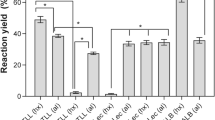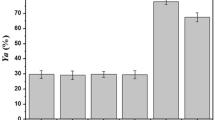Abstract
Various lipases were screened for their hydrolytic efficiency towards methyloleate. Lipase from Chromobacterium viscosum gave highest hydrolysis efficiency of 92% in 24 h. Different cation exchange resins were screened to immobilize lipase from Chromobacterium viscosum. A weakly acidic macroreticular type resin, IRC-50 having carboxyl end group functionality gave highest activity yield of 18.8%. Strongly acidic cation exchange resins with sulphonic functionality and macroreticular type did not give much activity yield when compared to weakly acidic non macroreticular type resins. It was observed that end group functionality and structure of the matrices plays an important role in obtaining highest activity yield. For a specific water concentration, the hydrolysis ratio reached 85% in less than 7 h when the substrate to enzyme ratio was 4. As the ratio is increased above 4, the availability of water at the interface has become a limitation for obtaining maximum hydrolysis.
Similar content being viewed by others
Author information
Authors and Affiliations
Additional information
Received: 12 January 1998
Rights and permissions
About this article
Cite this article
Murthy, M., Aslam Basha, Z. & Swaminathan, T. Hydrolysis of methyloleate using immobilized lipase from Chromobacterium viscosum . Bioprocess Engineering 19, 475–478 (1998). https://doi.org/10.1007/PL00009031
Issue Date:
DOI: https://doi.org/10.1007/PL00009031




